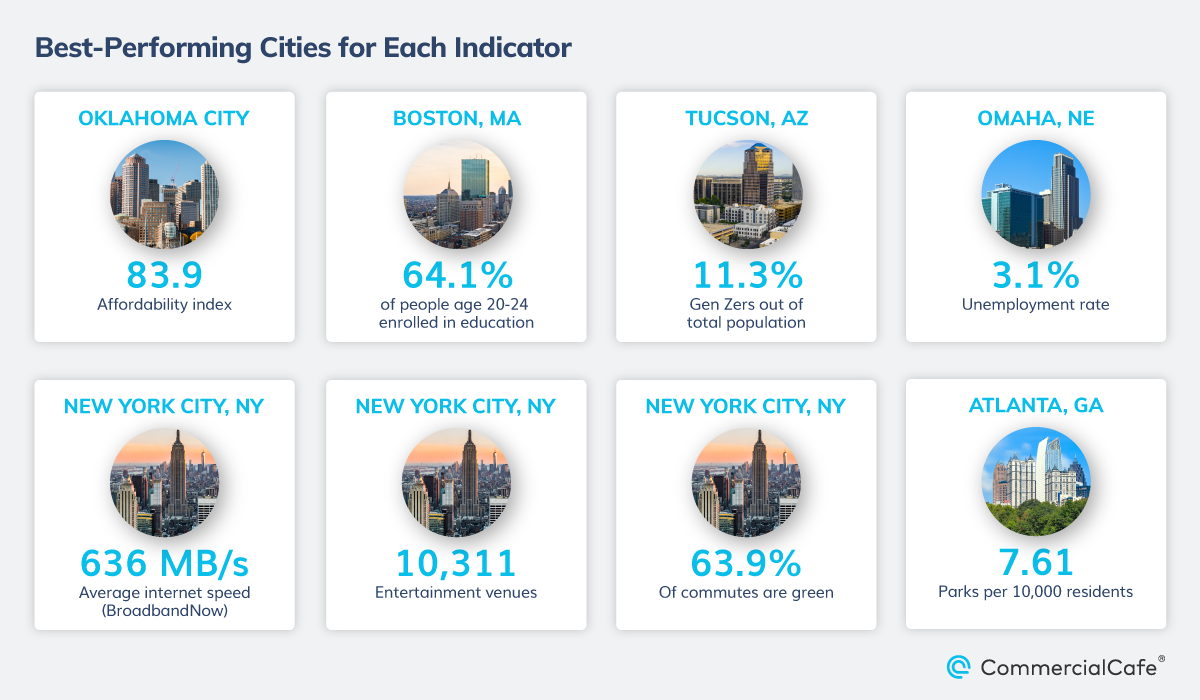Generation Zers are graduating and looking for their first jobs — and with the ubiquity of remote jobs, they have more flexibility than ever in choosing where they settle down. With this in mind, we set out to rank the cities that have the most potential as Generation Z havens. And Tucson ranks No. 4 among the best city for Gen Zers.
READ ALSO: Arizona No. 2 for largest house price appreciation
Notably, the majority of the best cities for this generation are concentrated in the Northeast, Midwest and Southwest. Moreover, our list features both affordable options with low unemployment, as well as larger cities boasting a variety of entertainment options, lightning-fast internet and highly educated Gen Z populations. Read on to learn the strong suits of each city:
Atlanta Secures Top Spot as All-Round Gen Z Magnet
Atlanta reached first place on our list of best cities for Generation Z with a total of 66.9 points — more than 3 points above the second position.

Specifically, Atlanta had the largest number of parks per 10,000 residents at 7.61. With gems that include Centennial Olympic Park; Piedmont Park (which is only a mile from the city’s downtown); and the historic Grant Park, just to name a few, Atlanta is a paradise for Gen Z joggers, pet owners or those who simply enjoy long walks.
However, the ratio of parks to residents wasn’t the only thing that Atlanta had going for it. First and foremost, members of Generation Z constituted 9.8% of the city’s population in the period of the study — the fourth-highest share on our list and a figure that is likely to increase given the city’s steady growth. Companies are also flocking to the city and Atlanta offices are in high demand, thanks to the area’s availability of educated young professionals.
Additionally, 55% of Atlanta Gen Zers were enrolled in some form of education — the second-highest Gen Z educational enrollment nationally. Coupled with a cost of life index near the national average and low unemployment (5.1%), Atlanta is a great candidate for ticking all of Gen Z’s boxes — community, walkability, economic prospects and educational opportunities.
Minneapolis, Boston Reach Podium with Strong Scores in Gen Z Population, Unemployment & Education
Minneapolis earned the runner-up spot thanks to its strong performances across most metrics for a total of 63.8 points.

The city had the third-highest percentage of Gen Zers of its total population, and more than half of Minneapolis’ adult-age Zoomers are enrolled in some form of education. Additionally, the city also had the fourth-lowest unemployment rate (3.8%) of the cities in our analysis, as well a cost of living on par with the national average. Clearly, with many companies looking for talent and a booming Minneapolis coworking scene, the city is a strong contender for freelancers and telecommuters.

Boston has the most educated Gen Z population of all of the cities in our study, with almost two-thirds of the city’s Zoomers aged 20 to 24 enrolled in some form of education. Meanwhile, Boston also had relatively low unemployment and a good availability of green commute options, while also having the second-highest percentage of Gen Zers out of all of the cities on our list.
In our previous ranking of the best metro areas for Generation Z, the Boston metro topped the list thanks to its high internet speed and personal income. And, while at a city level, Boston lost out due to lower affordability than the other podium entries, it still presents ample opportunities and advantages for Zoomers who graduate from one of its numerous universities or those who want to relocate to one of the nation’s tech and coworking hot spots.
Promising Generation Z Hot Spots Cluster in Northeast, Midwest & Southwest
The Northeast, Midwest and Southwest claimed the majority of the 20 best cities for Generation Z. With the exception of New York City closing out the top 10, all of the cities on our list had fewer than 1 million residents. However, they also varied greatly in aspects such as economy, Gen Z community, walkability and even climate, thereby providing a wide array of options for Zoomers looking to relocate or settle down for their first job — remote or otherwise.
The highest-ranked Southwest city was Tucson, Ariz., which reached #4 with a total of 59.1 points.

With the highest percentage of Gen Zers of all of the cities in our study (11.3%) — as well as great affordability, low unemployment and impressive internet speed — Tucson landed just shy of the top three. Compared to the cities on the podium, Tucson lost out due to a middling Gen Z educational enrollment and a lower number of green commute options and parks per residents. Still, members of the generation looking to join one of the companies operating from a Tucson office space should know that the city has plenty to offer, especially in one of its highly walkable and vibrant neighborhoods such as Armory Park or the Spanish-influenced El Presidio.
Besides Minneapolis, another flourishing Midwestern city also made the list: Columbus, Ohio, at #6 with a total of 53.7 points.

Columbus is one of the nation’s hot spots for young professionals looking for affordability in tandem with community. In fact, it was also ranked among the top 10 best U.S. metros for Millennials. Additionally, Columbus’ cost of living is 11% below the national average. The city’s affordability — as well as its relatively low unemployment — secured its finish high in the standings, while also cementing it as a strong option for Midwestern Gen Zers and more.

The only West Coast entry to crack the top 20, Seattle reached the seventh spot with stand-out unemployment and internet speed, as well as above-average showings in most other categories. Of course, it’s no secret that the city has become a hub for tech workers, freelancers and other digital nomads. Seattle coworking offices are also among the most sought-after in the U.S.
That being said, Seattle was the third-least affordable city in the top 10 (aside from New York City and Boston), but it made up for that with great education and job opportunities. So, if you’re looking for an economically booming city with a great sense of community, easy access to nature trails, and excellent walkability, Seattle should definitely be near the top of your list.

A duo of Texas cities reached #8 and #9 on our list of Zoomer-ready cities: In the eighth spot, Austin — a certified haven for Millennials and Zoomers alike and one of the fastest-growing cities in the U.S. — boasted affordability near the national average, as well as a 3.9% unemployment rate and good internet speed.

In the northwest part of the state, El Paso was the fifth-most affordable city of the 45 we analyzed. Boasting a larger percentage of Gen Zers than Austin, El Paso also had a higher unemployment rate at 5.9% and fewer entertainment options, so you’d have to counterbalance community with fun factor. However, if you’re considering one Lone Star State city over the other, keep in mind that both cities are heavily car-centric for commuting: Only 2.7% of El Paso commuters and 6.7% of those in Austin walked, biked or took public transportation to work.
NYC Places 1st in Internet Speed, Entertainment & Green Commuting as Omaha City Scores Lowest Unemployment

Some of the highest-ranked cities for Generation Z reached higher positions thanks to top performances across particular metrics.
For example, Boston’s percentage of Generation Zers older than 20 enrolled in education — 64.1% — propelled it to a podium finish, contributing almost one-third of its total points earned. Similarly, Tucson is the city with the most members of Gen Z out of the total population at 11.3%, helping it climb to #4 on our list, while Atlanta’s large number of parks also helped its claim to a top spot.
New York City is notable for being #1 in three different metrics: average internet speed (636 MB/s); number of entertainment venues and eateries (10,311); and percentage of commutes by public transportation, bike or on foot (63.9%).
Still, even with a full score in these indexes, NYC could only climb to #10. In particular, it was hindered by its low affordability, low Generation Z population share and relatively high unemployment. As such, while having the second-highest cost of living in the country, being in the country’s epicenter of business and taking advantage of the vibrant New York City coworking scene provides clear advantages.
Two cities could not crack the top 10 despite earning top scores in two respective metrics. Omaha, Neb., had the lowest unemployment of all 45 cities we analyzed at 3.1%. Besides full marks for its unemployment, the city also fared well in terms of school enrollment and number of parks, reaching #12 — less than a point behind New York City.
Likewise, Oklahoma City was the most affordable city on our list (followed by Tulsa, Okla., and Memphis, Tenn.). However, average or below-average scores in all other metrics except unemployment meant it secured a #24 finish. Yet, for remote workers or Zoomers looking for a quieter life, Oklahoma City could still be a great contender.



